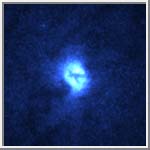|
COMETS EARTH JUPITER KUIPER BELT MARS MERCURY METEORITES NEPTUNE OORT CLOUD PLUTO SATURN SOLAR SYSTEM SPACE SUN URANUS VENUS ORDER PRINTS
PHOTO CATEGORIES SCIENCEVIEWS AMERICAN INDIAN AMPHIBIANS BIRDS BUGS FINE ART FOSSILS THE ISLANDS HISTORICAL PHOTOS MAMMALS OTHER PARKS PLANTS RELIGIOUS REPTILES SCIENCEVIEWS PRINTS
|
Related Document
Download Options
This image of the core of the nearby spiral galaxy M51, taken with the Wide Field Planetary Camera shows a striking, dark "x" silhouetted across the galaxy's nucleus. The "x" is due to absorption by dust and marks the exact position of a suspected black hole which may have a mass equivalent to one million stars like the Sun. The darkest bar may be an edge-on dust ring which is 100 light-years in diameter. The edge-on torus not only hides the black hole and accretion disk from being viewed directly from Earth, but also determines the axis of a jet of high speed plasma and confines radiation from the accretion disk to a pair of oppositely directed cones of light, which ionize gas caught in their beam. The second bar of the "x" could be a second disk seen obliquely, or possibly rotating gas and dust in M51 interacting with the jets and ionization cones. Image use statement at the time this image was obtained. All of the HST images available via WWW and ftp may be used without restriction as long as credit information accompanies the picture. Credit usually includes the principal scientist responsible for the data, AURA/STScI, NASA and/or ESA, the European Space Agency. Specific credit information may be found in the captions accompanying the images as plain text files. The captions are available via links from the Web pages as well as separate files in the gif directory on the ftp server. |
